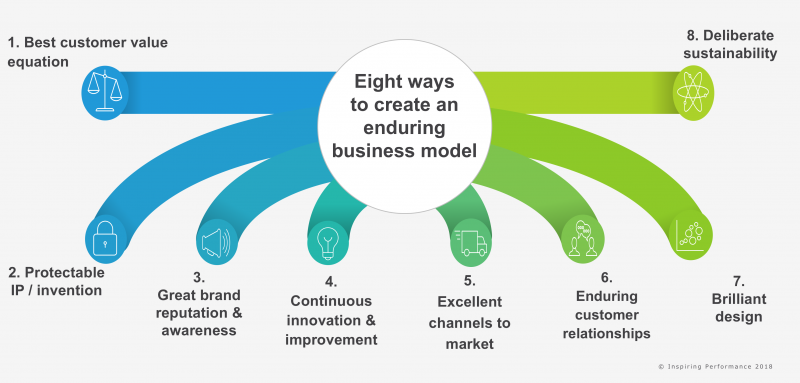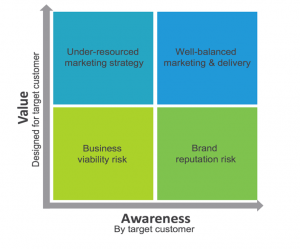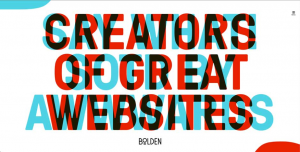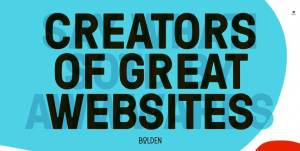Sustainable enterprise requires you to continually create value for a specified group of people. And your business model describes the logic of how you’ll deliver that value through to those customers/consumers.
But what are the ways you can do this to ensure you achieve your objectives, or grow faster than your industry peers?
Through our research and building strategy with over three hundred organisations, we’ve seen eight ways businesses can build their business model. Every organisation dabbles in them all, but Peak Performing organisations are an A+ in them all.
So, let’s look at each of them. As you read, ask yourself “How do we stack up out of 10?” What would others in your team think? Remember, it’s both clarity AND alignment of your strategy that matters.

1. Best customer value equation
This is the relationship between cost and quality – from the perspective of your customer and/or consumer. For instance, some people believe a BMW is the best car, but others think you can’t go past a 1992 two-door Honda civic!
But these are two very different target markets. So, in your market (or each of your target markets if you have more than one), how competitive are you when it comes to ‘value for money’?
YOUR SCORE … / 10
2. Protectable IP / invention
Creating and leveraging your know-how and special competencies (or creating some) can lead to exciting opportunities. On the other hand, some groups find it hard to see if they’ve got anything worth protecting – yikes!
Whichever camp you sit in, it’s a critical conversation to have. It might take a bit of effort and resource to protect your knowledge, but it’ll likely cost a lot more if you don’t.
When we talk about ‘IP’, it’s generally accepted to include:
• Patents;
• Trademarks;
• Protected designs;
• Copyrights; and,
• Trade secrets
Let’s look at Coca-Cola® as an example. The brand, “Coca-Cola”, is a trademark. The formula for the contents of the bottle is a trade secret, while copyright protects the packaging art. The shape of the bottle is even protected by both a design patent and trademark.
Sure, they tick a bunch of boxes there, but how about a smaller business leveraging the same principle in their strategy. A New Zealand based aluminium boat manufacturer, Surtees, turned their experience and know-how into a marketing driver called ‘SIQ’ – Surtees Intelligence.
What protectable IP do you exploit throughout your business model? Exploring this is a core function in our strategy-building process with clients.
YOUR SCORE … / 10
3. Great brand reputation & awareness
“Your brand is what people say about you when you’re not in the room”
– Jeff Bezos, founder of Amazon
We reckon Jeff’s spot on, and it’s always fun working with businesses to compare how they’re promoting themselves vs. the emotions and perceptions in the minds of their markets. You can think of this principle as an individual as well!
Are all of your actions and decisions reinforcing your brand? Or are your customers ambivalent and would happily walk past you if another option was on the table?
Also, we’ve seen some organisations having strong market awareness in the marketplace, but the value of their goods (designed for the market) doesn’t match it. Others have brilliant products and services but no-one in their target market knows of them! Where do you sit?

This relates to marketing strategy. That is, the people, processes, plans and actions you undertake to promote, price, place, and package your goods to be valued by, and attractive, to customers. Marketing strategy should lead directly from business strategy and will be a key determinant of your business’ performance.
YOUR SCORE … / 10
4. Continuous improvement & innovation
A great product yesterday doesn’t mean it’ll be loved tomorrow. By understanding the changing and evolving lives of their customers, Peak Performing organisations evolve their offering to keep ahead of their competitors.
Apple are famous for adding more functions to iPhones each year. You can decide if their changes in the last couple years have been as impactful as the early days.
But innovation can occur far beyond just the features of your current products and services. Have a think about where you currently play within your own industry or global value chain. Through the lens of your purpose (assuming you have one), can you imagine expanding the horizon of business potential by also expanding your offering?
During our workshops, we map out your current supply and value chain and test where there could be opportunities. Our research on a few hundred organisations has uncovered some interesting trends!
YOUR SCORE … / 10
5. Excellent channels to market
‘Channels’ refers to the people or groups that are involved in the promotion, selling and distribution of your products/services. And in simple terms, you’ve got a few choices: directly, indirectly, or both.
Sounds simple, right? Hmmm.
Deciding on the right channel strategy can be complex, because your decision will impact your ability to control the customer experience, and the performance of the individuals and teams doing the work. And it can have a fundamental impact on the governance and structure of your organisation – for example, creating a network of franchises.
Many of the organisations we’ve worked with have some aspect of indirect channels in their strategy, largely because the supply/value chains in most industries around the world are so well networked nowadays. Also, with the growing understanding and use of blockchain, consumers will soon benefit from greater guarantees of the origins and integrity of products.
Channel strategy is an exciting topic that deserves its own blog, so let’s just focus on the questions you should ask yourself here: “How effective (or excellent) is your channel strategy for marketing your goods, and how they’re distributed, to achieve your organisation’s overall objective?”
YOUR SCORE … / 10
6. Enduring customer relationships
Organisations wanting to become Peak Performers can’t do it without loyal customers. In virtually every industry nowadays, the relationship between you, your channels, your customers and your consumers is getting closer. What is your ability to build enduring relationships with your customers based upon bespoke (or co-created) solutions?
This is reinforced by a recent Deloitte study showing organisations are leveraging crowd-sourced ideas with active followers to influence design.
Software has obviously helped this. For example, supermarkets enable shoppers to have ‘saved’ shopping lists in their accounts. But beware of mistaking ‘bespoke’ with ‘spooky!’.
Target’s data on consumer behavior was found to be so clever it started sending mailers of pregnancy products to the home of a teenage girl in the US. After her father complained to the store manager, he had to go back a few days later…
“I had a talk with my daughter, and it turns out there’s been some activities in my house I haven’t been completely aware of. She’s due in August. I owe you an apology”.
Great use of data, but perhaps lacking a little EQ by Target.
In your business, how much flexibility is there in your products and services to adapt to the specific needs of a specific customer?
YOUR SCORE … / 10
7. Brilliant design
Thoughtful design of product and service experiences lies at the heart of creating customer value and brand differentiation. Design relates to the functional, aesthetic and emotional aspects of customer experiences.
It’s hard to achieve any of this without truly understanding who your customers and users are and how they live. “Customer empathy” is the phrase design-junkies use, and for good reason.
Don’t make the mistake of thinking ‘clever design’ is the same as ‘good design’. For example, graphical sensations might capture your imagination, but that doesn’t make it good design.

Take Dutch strategic design and development studio Bolden’s website. Can you tell what their home page is trying to say? No? Well, that’s because you’ll have to move your mouse to the very corner of the page to see the message. Clever? Yes. Bad design? Absolutely!

So, to what extent in your business is the value proposition and design of your goods entirely based upon how users and consumers think, feel, act or believe? How does this knowledge ensure the functional, aesthetic and emotional aspects of their experience is brilliant?
YOUR SCORE … / 10
8. Deliberate sustainability
Sustainability is the ability of your organisation to continue operations into the foreseeable future. Historically this has been seen primarily through a financial or economic lens, but organisations are now being held to environmental, ethical and social standards, and are punished by consumers and/or legal requirements if they fail to do so.
Let’s look closer at ‘ethical and social standards’ by going back to the pregnancy example of Target, and how they left their moral compass in the carpark one day. Here’s what one of their statisticians, Andrew Pole, described as their strategy after the PR disaster with the pregnant teenager.
“Then we started mixing in all these ads for things we knew pregnant women would never buy, so the baby ads looked random. We’d put an ad for a lawn mower next to diapers. We’d put a coupon for wineglasses next to infant clothes. That way, it looked like all the products were chosen by chance.
We found out that if a pregnant woman thinks she hasn’t been spied on, she’ll use the coupons. She just assumes that everyone else on her block got the same mailer for diapers and cribs. As long as we don’t spook her, it works.”
Smart and effective? Yep. Mis-leading and dangerous? Let us know what you think!
Like Nike being accused of sweat-shop-manufacturing, organisations’ decisions about the sourcing of materials, processes and their behaviors are more visible now than ever before.
How about the longevity of your products? That comes under our sustainability banner.
So does the quality of your operating model. Will enable you to sustainably deliver your strategy? That is, governance, systems, communications, people and performance, etc?
Sustainability is a big topic, and Mike has been thanked by clients around the world for the workshops where he has helped them build a specific plan on the topic. In your organisation, do you have a plan to encourage and build greater sustainability for the future?
YOUR SCORE … / 10
Or, what was your total out of a possible 80?
So, what can you do with all this?
First, don’t think about this on your own! Peak Performing organisations have clarity and alignment of their strategy, direction and priorities. Have a conversation about these eight types with your team. Even better, get each person to rate your organisation on each of the eight before chatting!
Perhaps any lack of alignment is an easy fix with improved communication and education for staff. If there is a potential crevasse when you look at them, is your current strategy addressing them? If not, it might be time to re-think what your priorities are.
If this has made you interested in learning more about the research and work we’ve done with other aspirational businesses wanting a plan that’ll help them be the best they can be, get in touch.
Our Peak Performance strategy process will get you all rowing in the same direction and help prevent any angry fathers calling your reception!
Here’s what one company recently said about the process:
See all posts“The process and facilitation engaged our Board and Management like never before. Every layer of our organisation is now heading in the same direction. Thank you!”
